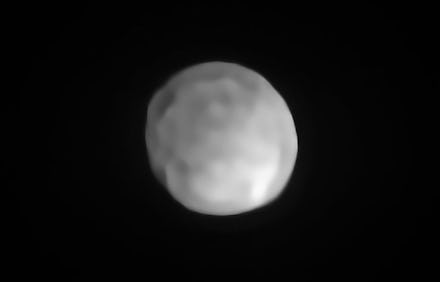Astronomers may have identified a dwarf planet almost 6 times smaller than Pluto

Astronomers may very well have stumbled across one of the smallest dwarf planets our solar system has ever seen. Using the European Southern Observatory's powerful SPHERE imaging system at the Very Large Telescope array (VLT), a team was able to snap a new image of an object that's now being called Hygiea, found within our solar system's asteroid belt. The fourth largest object in the solar system's asteroid belt after Ceres, Vesta, and Pallas, this is the first time researchers have been able to observe Hygiea with enough detail and resolution to determine what its size and shape may be. With the new information, it could finally be classified as a dwarf planet.
For Hygiea to be considered a dwarf planet and not an asteroid, it has to satisfy certain requirements. As such, it meets three out of four already: it is not a moon, it orbits the Sun, and it has not "cleared the neighborhood around its orbit." This means that it will have become gravitationally dominant – simply put, there aren't any other bodies of a similar size other than its natural satellites around it. The final requirement would need Hygiea to have enough mass for its own gravity to help form it into a spherical shape.
That's what researchers using the SPHERE have been trying to determine as of late, and thanks to this new image, they've basically accomplished just that.
"Thanks to the unique capability of the SPHERE instrument on the VLT, which is one of the most powerful imaging systems in the world, we could resolve Hygiea's shape, which turns out to be nearly spherical," said lead researcher Pierre Vernazza of the Laboratoire d'Astrophysique de Marseille in France. "Thanks to these images, Hygiea may be reclassified as a dwarf planet, so far the smallest in the solar system."
You're likely already familiar with the most well-known dwarf planet in our solar system: Pluto. Hygiea is just over 430 km in diameter, while Pluto is much bigger at 2400 km. Hygiea is even smaller than dwarf planet Ceres, which is nearer to 950 km in size.
The new image of Hygiea that helped the team determine its eligibility as a dwarf planet also revealed that it does not have any impact craters on its surface. Researchers have posited that whatever event led to the creation of a massive body of asteroids, the same one Hygiea belongs to, would have left some sort of impact crater on the space object's surface. Surprisingly, there was no impact crater there.
"This result came as a real surprise as we were expecting the presence of a large impact basin, as is the case on Vesta," said Vernazza. They did see two craters, but they weren't what the team had been looking for. "Neither of these two craters could have been caused by the impact that originated the Hygiea family of asteroids whose volume is comparable to that of a 100 km-sized object. They are too small," said study co-author Miroslav Bro, from the Astronomical Institute of Charles University in Prague, Czech Republic.
The team deduced that due to Hygiea's shape and size, it must have been the result instead of a collision with an object between 75 and 150 km in diameter, believed to have happened over 2 billion years ago. It's thought to be a mass assemblage of pieces that were once shattered and brought together again in a spherical shape. This type of collision is "unique," according to researchers from the Astronomical Institute of Charles University.
The team is continuing to evaluate Hygiea and its shape and size, but we may have finally found a contender for our solar system's smallest dwarf planet. With the type of imaging SPHERE provides, there's a whole world of discoveries out there about other celestial bodies just waiting to be made.